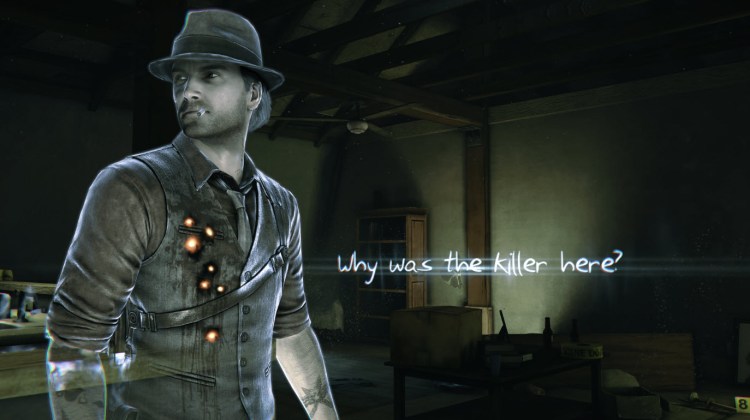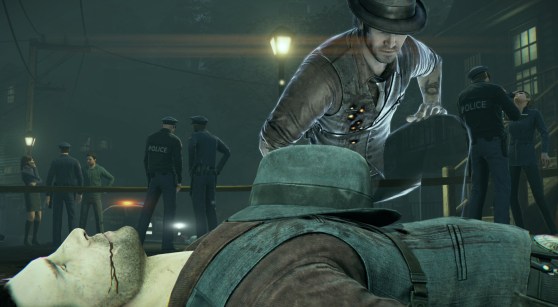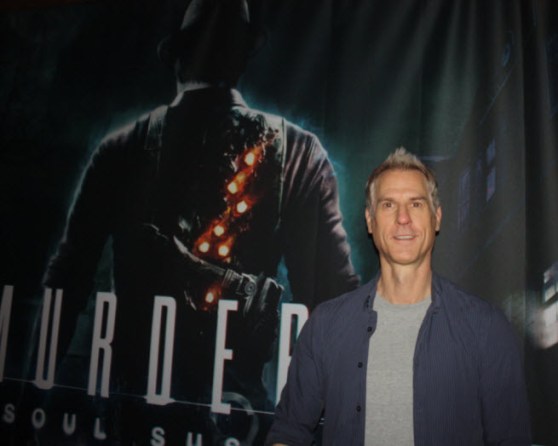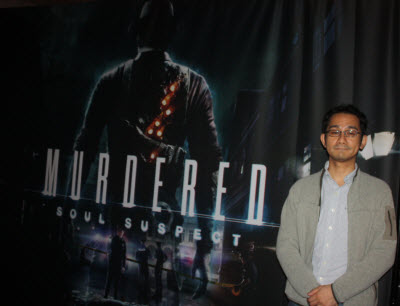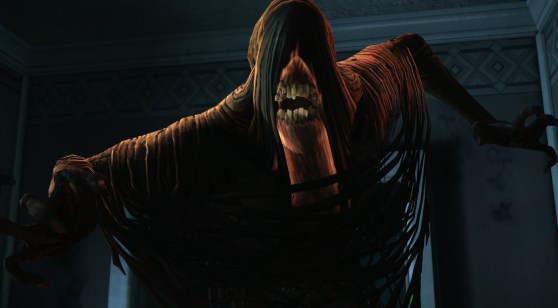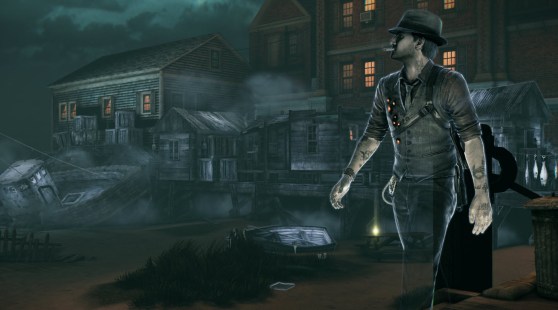Square Enix and developer Airtight Games are taking their time with Murdered: Soul Suspect, an original mystery game for the newest generation of consoles and the PC. They unveiled the game at last year’s Electronic Entertainment Expo video game trade show, and now they’re giving a hands-on peek at the first hour or so of the title.
I’m glad to report that the game has made a lot of progress since I last saw it. It still has some bugs. But the version I played was much better than last year’s prototype. I liked this game because it had an original premise where death is just the beginning of the story.
The noire-like game opens with Ronan O’Connor, a detective in Salem, Mass., being thrown out of a fourth-story window by a mysterious hooded figure. He gets up and tries to get back in the building but finds that his body is still on the ground. He is a ghost, and his physical body is fading fast. The hooded figure appears, grabs Ronan’s gun, and then shoots him seven times. Ronan realizes that he is dead, and his mission is to solve his own murder.
That’s a compelling opener for a very different kind of video game, which is full of suspense but not horror. The “dusk” world that Ronan’s ghost inhabits is a kind of purgatory. Ronan has to resolve his own issues as a ghost before he can move on to the afterlife. It is a dangerous world, but not one with the traditional kind of combat that you find in most games.
Murdered: Soul Suspect was so refreshingly different that it was one of my favorite games previewed at E3. But critics who were pickier than me found fault with the lack of interactivity and the sense that it was more of a movie than a game.
“We made a lot of tweaks to it, but it’s still the same fundamental game,” said Matt Brunner, the chief creative director at Airtight Games, in an interview with GamesBeat. “It’s an investigation game where you’re trying to solve your own murder.”
I wouldn’t say that the experience is as rewarding as my top games of last year — The Last of Us and BioShock Infinite. But if the developers bring this big project home, it will bust open a new genre of non-combat mystery games that are relatively rare among triple-A productions. I think it has every chance to be as compelling as last year’s favorites.
- Ronan realizes that he’s a ghost and is looking at his dead physical body.
The hands-on gameplay
As Ronan, you have to get used to being a dead guy. You have no physical form. You can’t talk to the living or move things in the real world. You run into other ghosts in the limbo world of “the Dusk,” which has a fuzzy, murky, dusty feel to it. As a ghost, you can see the living. But you also see the shimmering, specter-like forms of other ghosts in the Dusk. Some of them will talk to you and plead for help. That leads you on side stories that take you off the critical path.
If you want, you can ignore the other ghosts and focus only on solving your own murder. But if you help the ghosts resolve their problems, you learn more about the history of the place, about Salem, and find clues that may help you.
Ronan’s brother shows up at the scene, so the story introduces characters among the living. And it introduces characters among the dead, including Ronan’s girlfriend, who died earlier. Last year, there was no mention of the girlfriend, but her presence in the cinematics of the opening scene paints Ronan, a tough-guy detective, in a different light. He wants to be reunited with her, but she tells him he must solve his own murder before he can move beyond the Dusk.
In the opening episode, you find that there are advantages to being a ghost. You can slip into the bodies of the living and possess them. You can read their minds and eavesdrop on their conversations. You find that one of the cops really hates you because of your chequered past and that he’s glad you’re dead. You can influence real people to do things, like move paper so that you can see what is underneath it. That helps you find clues. And if you’re a good detective, you’ll pursue every thread since you don’t know what clues will be important.
When you discover a clue, you add it to your collection. Once you collect all of the clues around the crime scene, you reconstruct what happened. If you guess correctly which of the clues are most relevant to your murder, then you solve the puzzle and are able to move to the next scene. You can make a guess before you have all the clues, but if you guess wrong, there is no huge consequence. You simply won’t get a perfect score in your game achievements.
Once you solve the first puzzle, you can move inside the building to find out what is on the fourth floor. But as soon as you get inside, you run into another ghost. She was murdered and wants to know why. You can solve that mystery by looking around the first floor. I meticulously searched through the whole floor. That’s not the typical behavior you have in a game. Most gamers are in a rush to find an answer, solve a puzzle, or head into combat.
In this game, you have to search and think. It’s not survival horror, said Naoto Sugiyama, the executive producer of Murdered. You don’t get jumped in the dark or have to blast your shotgun at flesh-eating zombies. But it is scary, dangerous, and suspenseful. The reason why it’s different from your standard horror or combat game reflects a lot of thought.
The design decisions that made Murdered come together
When Square Enix began working on the game years ago, its ambition was to expand beyond its Final Fantasy role-playing games, which were strong in Japan, and expand to content that appeals to Western audiences. It partially succeeded with last year’s release of Tomb Raider, the reboot of the Lara Croft franchise. But Murdered is a bet on a brand new story and intellectual property.
The idea originated with Yosuke Shiokawa, the creative director at Square Enix, who was inspired by the movies Die Hard and Ghost. What would happen, he thought, if ghosts could communicate across the life-death barrier? And the Bruce Willis character from Die Hard would still try to protect his wife even after he died. The plot of the game was unchanged: to have the ghost, Ronan O’Connor, solve his own murder.
So Sugiyama and Shiokawa teamed up with Quantum Conundrum developer Airtight Games to flesh out the idea. They toiled for a long time, trying to get the gameplay and story right. Among the problems was differing interpretations between the Japanese and the Americans about how ghosts should behave. They settled upon an approach in 2010, Sugiyama said, and they have been in production ever since.
“It was a loose idea, so there was a lot of freedom in the development process,” Brunner said. “The process about melding the Japanese sensibility with the American sensibility about what a ghost behaves like was rough. It took us a good year and a half to get that sensibility.”
The key to the design came with the creation of the character, Ronan. He was a tough detective who got himself killed and didn’t know why.
“That really began to resonate with us,” Brunner said.
The team had to think about the core gameplay that would support the fantasy of being this character. That led to the notion of building the game around investigation and finding clues. The world had to have danger for both emotion and engagement. That was where the narrative and the gameplay came together. The design decisions grew from the core idea and the core character, like layers being added to fulfill the experience.
The game is set in Salem, Mass., the site of the Salem witch trials. It gave the game its distinctly American flavor, and it brought in a rich supernatural history as the backstory that could hold the game together, Brunner said. The small-town setting allows for focused investigation scenes. This isn’t a giant, open world where you can go anywhere. The first hour of the game takes place inside the single building and the crime scene surrounding it.
With the Salem history, pieces of the story fell into place. The ghosts can’t go inside all buildings. They are blocked from going inside “consecrated” places, so they have to find an open window or walk into a building by following a human being who goes inside. So ghosts can move around inside buildings, but they can’t get out of them or into them so easily. The space where they can operate is contained into a kind of arena. The ghosts can’t just run away from every fight or enemy.
Fighting with demons: the trickiest part of the gameplay
One of the dangers of being a ghost is that you aren’t invulnerable. You can be destroyed by demons like the one pictured above before you find your way out of the Dusk. That means that you have to think about what you do before you act. The first demon appears on the second floor of the building as you walk up the stairs. You have to flee. You can press the right bumper of the controller to glance through a wall to see if the demon is lurking there. If you sneak up behind the demon, you can kill it using a quick controller maneuver. But if the demon turns around, it will grab you.
The gameplay also has a stealth element, too. There are ghostly mists that you can hide in to escape from the demons. You can move from mist to mist in order to maneuver away from the demon. You can imagine that this cat-and-mouse game between hunters and the hunted could be used in multiplayer, but the game has no multiplayer, Brunner said.
“I don’t think of it as combat at all, and we don’t want to turn this into a combat game,” he said.
The point of the demons is show you that the Dusk is a dangerous world. There are enemies that you have to stay away from as you try to find clues.
Once you make it past the demons on the second and third floors, you can finally get to the apartment you’re looking for. A flashback shows that Ronan was responding to a burglary call and surprised the hooded figure. The hooded figure is supernaturally strong, and he starts throwing Ronan around. Then he throws him out the window. At that point, the flashback ends, and Ronan has to look around the apartment for clues.
He discovers that a girl came into the apartment and was hiding just as Ronan surprised the intruder. The girl flees during the fight. Once Ronan picks up clues about the person who lives in the apartment and solves the puzzle, he can proceed in search of the girl. When Ronan leaves the building, he has an opportunity to help another ghost with another side quest. The interspersing of these side stories with the critical path of the main story will keep the explorer in you engaged.
But Brunner said the team held back from staging epic combat battles. That helped slow the pacing of the game to fit the investigative gameplay. Of course, the designers didn’t want the game to be too slow-paced and non-interactive, like a movie.
“You really need to have moments of peak adrenaline,” he said. “But the question was how to make the investigation more engaging, to make the player think. We made changes to the smallest things during the past year that helped make the game more interactive.”
Conclusion
That was all I got to see of the game. But I’m very excited to see more and to play it. I like the original thinking behind the making of the game, and I’m interested in the situations that Ronan will explore and the story that he unravels. I’m also intrigued by the side stories that delve into the history of Salem, and I’d like to know what kind of capabilities the ghost can develop over time. If the team follows through on its vision, it should have one of the most interesting games of the year.
The title will be coming to the Xbox 360, PlayStation 3, Xbox One, PlayStation 4, and the PC.
VentureBeat's mission is to be a digital town square for technical decision-makers to gain knowledge about transformative enterprise technology and transact. Learn More
